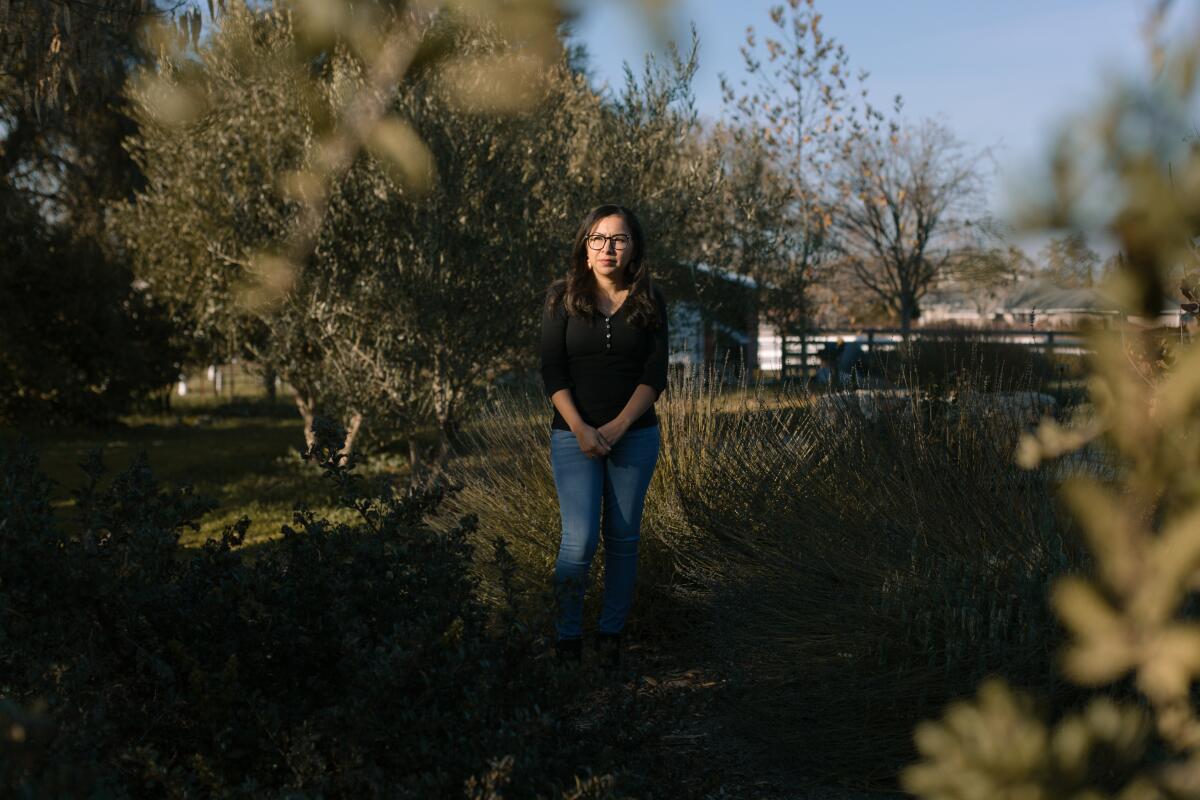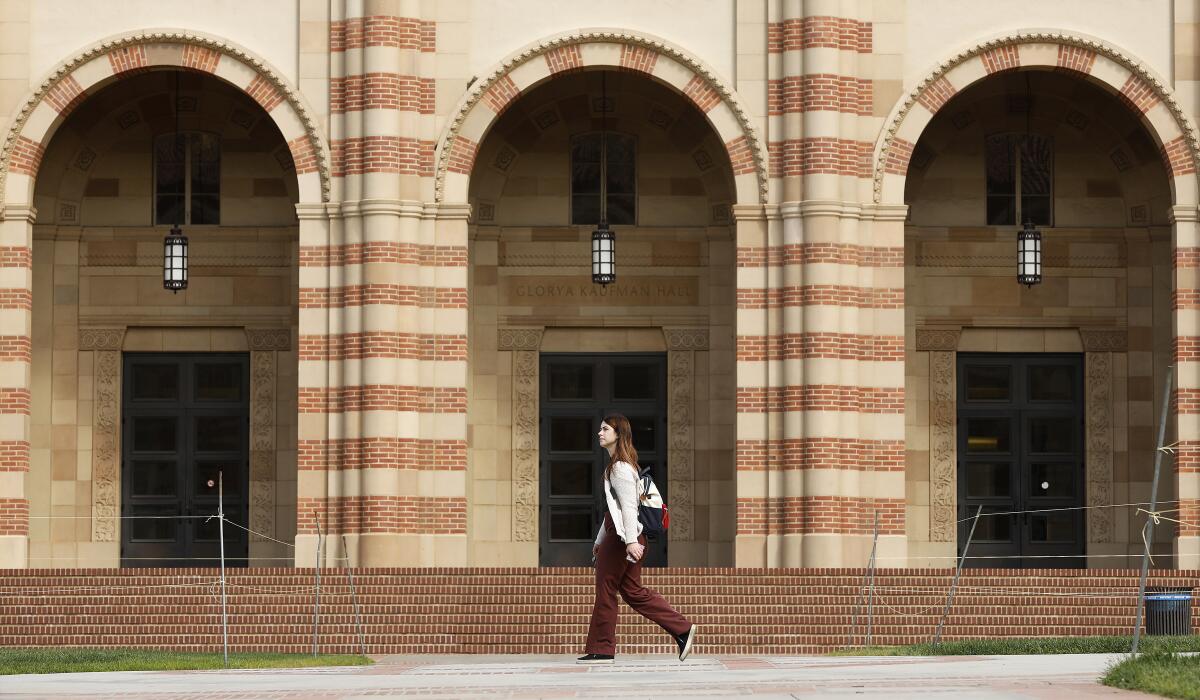The L.A. County Sheriff’s Department and its secret societies

- Share via
Good morning, and welcome to the Essential California newsletter. It’s Wednesday, March 23. I’m Justin Ray.
Let’s talk about gangs — and not the street gangs you usually hear about, but the gangs composed of the people tasked with serving and protecting the public.
As readers of this newsletter know, I’m interested in the subject of policing. My conversations with police chiefs in Sacramento, Oakland and Fresno provided a candid look at law enforcement by those on the inside. I’m interested in finding out truths about those who are supposed to be keeping us safe
One of those truths is that hundreds of Los Angeles County sheriff’s deputies have said that they have been recruited to join secretive, sometimes gang-like cliques that operate within department stations, sheriff’s deputies themselves disclosed in a survey.
Alene Tchekmedyian, who does some of the best police reporting you will read at The Times, reported that the top watchdog for the Los Angeles County Sheriff’s Department identified more than 40 alleged members of gang-like groups of deputies. They operate out of a pair of sheriff’s stations.
Groups, whose members typically get matching tattoos, go by names such as the Grim Reapers and Jump Out Boys. They’re not new; the groups have existed for decades and, thanks to lawsuits, have been expensive to taxpayers.
These secret societies have been accused of glorifying an aggressive style of policing. Defenders of the groups, however, say they boost morale by fostering camaraderie. Knock L.A. has done extensive, important reporting on “deputy gangs.”
The public only gets glimpses of these secretive groups when lawsuits crop up citing the existence of such cliques. Here are some things we do know:
- Sheriff Alex Villanueva, who before being elected worked hard to court liberal and progressive voters, has downplayed the problem. He sent a cease-and-desist letter to the Board of Supervisors, demanding that they and others stop using the phrase “deputy gangs.” He called the term “willful defamation of character.”
- In September 2018, two deputies were knocked unconscious at a department party, according to a lawsuit. The incident was the focus of two internal investigations — one of which Villanueva has said led to the discipline of 26 employees.
- In 2020, Tchekmedyian reported that Los Angeles County had paid out roughly $55 million in settlements in cases in which sheriff’s deputies have been alleged to belong to a secret society. She cited a report prepared by L.A. County attorneys that listed almost 60 cases and named eight cliques. The largest payout on the list — $10.1 million — went to Francisco Carrillo Jr., who spent 20 years behind bars before having a murder conviction overturned in 2011.
- The FBI investigated deputies over allegations of beatings and harassment, it was reported in 2019. FBI agents were reportedly looking into whether the so-called Banditos had been requiring or encouraging aspiring members to commit criminal acts, such as planting evidence or writing false incident reports, to secure membership in the group. The current status of the investigation is not clear.
And now, here’s what’s happening across California:
Note: Some of the sites we link to may limit the number of stories you can access without subscribing.
This California wine country town is multicultural. So why do so many people of color feel invisible? Across the nation, U.S. history has been drafted into the culture wars. This is certainly the case for schools grappling with issues of race and education. A group of parents, students and activists recently fought to reinstate an ethnic studies course at Paso Robles High School after a decade of going without one, only to face detractors who argued that it could inflame racial resentments. “What does it say about Paso Robles, a multicultural city where almost 1 in 5 residents is foreign-born, that a backlash took root here, too?” Tyrone Beason writes. Los Angeles Times

L.A. STORIES
Column: UCLA advertised a faculty job that carried no pay whatsoever. I was one of many people who saw this job listing, which raised eyebrows. In the posting that appeared this month on UCLA’s internal recruitment website, the university specified that “applicants must understand there will be no compensation for this position.” In other words: no salary, no benefits. But there were many prerequisites. In an apologetic online statement, UCLA’s dean of physical sciences wrote, “We recognize the language in this particular advertisement could have benefitted from additional context.” How does Times columnist Michael Hiltzik feel about the whole situation? He doesn’t hold back. Los Angeles Times

Nearly all of the big-name candidates for Los Angeles mayor took aim at Rick Caruso, attacking the real estate developer over his police spending plan, his support for Dist. Atty. George Gascón and his personal yacht in the first televised forum to feature all five onstage. While most of the other candidates have had to raise money in $1,500 increments — the maximum permitted per donor per election cycle — Caruso has been able to tap his personal wealth. Tuesday night’s debate at USC’s Bovard Auditorium was co-sponsored by The Times, USC Dornsife Center for the Political Future and Fox 11, with Times columnist Erika D. Smith and Fox 11 anchor Elex Michaelson serving as moderators. Los Angeles times
Our daily news podcast
If you’re a fan of this newsletter, you’ll love our daily podcast “The Times,” hosted every weekday by columnist Gustavo Arellano, along with reporters from across our newsroom. Go beyond the headlines. Download and listen on our App, subscribe on Apple Podcasts and follow on Spotify.
POLITICS AND GOVERNMENT
‘The law that swallowed California.’ Liam Dillon is out with a deep dive on the law behind all the drama involving UC Berkeley’s enrollment. “Although the California Environmental Quality Act, or CEQA, has made it harder to drain wetlands, pave nature preserves and build oil refineries, it has also stymied the construction of bike lanes, affordable housing and public transportation,” Dillon writes. (He also has a great podcast about why it is so expensive to live in California.) Los Angeles Times

Gov. Gavin Newsom has a proposal for compelling people into court-ordered treatment for mental illness and addiction. It might, however, amount to a build-the-plane-while-it-flies approach. “We’re coming up with a completely new paradigm, a new approach, a different pathway, and it’s consistent with our values,” Newsom said earlier this month when he announced the Community Assistance, Recovery and Empowerment Court. The Times has more details on the CARE Court proposal. Los Angeles Times
CRIME, COURTS AND POLICING
The San Diego County district attorney’s office is proposing a new type of court, legislative changes and other strategies to help homeless people with mental illness avoid incarceration and receive psychiatric help. The plan is part of what Dist. Atty. Summer Stephan called a three-tier Homeless Enhanced Legal Program, or HELP, that would include diversion programs before and after charges are filed against a homeless person facing a low-level offense. The idea would be to get people help upstream, before they face serious charges, and also help them avoid becoming repeat offenders. San Diego Union-Tribune
Man denied bail in ‘unspeakably violent assault.’ A judge in Stanislaus Superior Court set no bail for a man accused of kidnapping and severely beating a woman in an attempt to sexually assault her. Ellis Jamal Grey, 42, was on parole for previous violent felony convictions before the incident, Deputy Dist. Atty. Patrick Hogan said. Grey allegedly grabbed the woman, who didn’t know him, and dragged her several blocks to a yard. Hogan said the suspect “brutally assaulted her by stomping on her face” until witnesses called police. He has pleaded not guilty. Modesto Bee
Support our journalism
HEALTH AND THE ENVIRONMENT
California may see a scourge of genetically modified mosquitoes — but that may be a good thing. The insects, developed by the British biotech firm called Oxitec, are a modified male version of Aedes aegypti. They are an invasive species known to carry dengue, Zika and a host of other diseases. But the modified version of the mosquito has a gene that will ensure that female offspring do not grow into childhood. Male offspring, however, will survive and continue to pass down the gene to further generations to kill off the invasive species. If the Department of Pesticide Regulation approves the plan, the first city that will see the mosquitoes is Visalia, reports the Bay Area News Group. SFGATE
CALIFORNIA CULTURE
Hunters are fighting a bill making its way through the California Legislature that would loosen restrictions on killing wild pigs doing damage to agricultural lands. Killing a hog without a license and tag or a depredation permit is punishable by a misdemeanor charge, potentially thousands of dollars in fees or even jail time. Although wild hogs are despised by vineyard owners and other farmers, hunters get paid a lot to remove the hogs. If it becomes easier for anyone to off a hog, they lose big business. Sacramento Bee
Free online games
Get our free daily crossword puzzle, sudoku, word search and arcade games in our new game center at latimes.com/games.
CALIFORNIA ALMANAC
Los Angeles: Sunny, 89. San Diego: Sunny, 80. San Francisco: Overcast, 61. San Jose: Sunny, 75. Fresno: Sunny, 88. Sacramento: Sunny, 83. The space between your eyebrows is called your “glabella.” You’re welcome.
AND FINALLY
Today’s California memory is from MeraLee Goldman. I love this one:
I arrived at Stanford University as a 16-year-old freshman from Chicago, Illinois. Dinner the first night, in the freshman dorm for women, began with a really strange-looking green object sitting on our plates. No one at the table knew what it was or how to eat it. I had seen my cousin’s toddler eating one like it a few nights before school started. She pulled off the leaves and scraped them on her teeth — what a mess! Well, I might not know what it was or how to properly eat it, but I knew I wasn’t going to look silly eating it like a toddler! Imagine my surprise when it turned out that was the only way to eat this delicious artichoke!
If you have a memory or story about the Golden State, share it with us. (Please keep your story to 100 words.)
Please let us know what we can do to make this newsletter more useful to you. Send comments to essentialcalifornia@latimes.com.
Sign up for Essential California
The most important California stories and recommendations in your inbox every morning.
You may occasionally receive promotional content from the Los Angeles Times.




